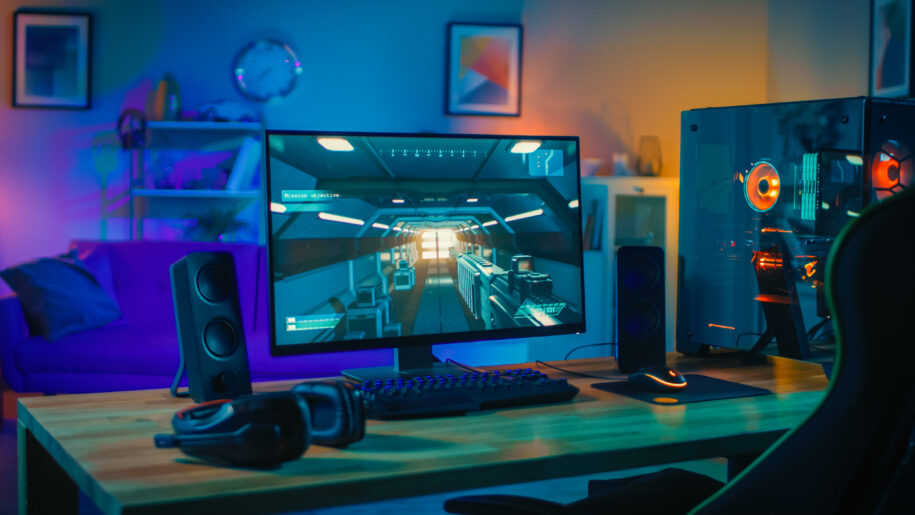
You can have the fastest gaming PC in the world, but you won’t experience the difference having that many frames per second makes if you aren’t gaming at a high a refresh rate. This article will explain what refresh rate is and how it impacts your gaming experience.
Playing games at a high framerate on a high refresh rate monitor feels much smoother than playing on a lower refresh rate monitor. This smoothness and extra frames are all the more crucial when playing competitive games where every frame makes a difference between victory and defeat.
A high refresh rate monitor, like a 144Hz or 240hz or even a 360Hz, will not make a difference if your gaming computer is not fast enough to output that many frames per second in the games you are playing.
Refresh rate refers to the frequency your display updates onscreen images. Time between these updates is typically measure in milliseconds (ms). The refresh rate itself is expressed as hertz (Hz).
Combining both of those together, refresh rate is how many times a second your display is able to update or draw a new image. A 60Hz monitor can refresh the image on screen 60 times every single second, a 144Hz monitor can refresh the image on screen 144 times a second, and so on.
Pairing a monitor that can refresh many times a second, along with a computer that produces high frame rates from a GPU and CPU working together, makes for a smoother gaming experience.
Keep in mind the monitor can only display an image at the rate your computer can push them out, so that’s why higher performance hardware is crucial to get the full benefit of monitors with higher refresh rates. If your GPU can only push out 30 frames per second, but you have a blazing fast 360 Hz monitor – you aren’t utilizing that extra fast refresh rate to enjoy smoother gaming. But, you do have a sweet monitor – so you do you.
How Hardware Effects Frame Rate
Different games can put a varying amount of load on your graphics card and processor. Older games and games that are not as graphically intensive utilize less resources than a AAA release with cutting edge technology. So depending on the game you could push out high frame rates, even on lower end hardware.
The combination of your hardware’s performance, the game’s resource demands, and the graphics settings and resolution you select in the game can all contribute to how many frames per second your get.
In ideal world you want your in game frame rate to match your monitors refresh rate for the smoothest possible gaming experience. But if you fall a little short of your target, let’s say your favorite game runs at 100 fps on your hardware and you have 144Hz monitor, you are still going to feel the smoothness of those extra frames versus playing at 60 fps on a 60 Hz monitor.
What is Adaptive Sync?
Most monitors today come with some form of adaptive sync. You’ll notice that your monitor has either FreeSync or G-Sync. The name of you adaptive sync is less important nowadays, they essentially both do the same thing. Adaptive sync makes your display communicate directly with your graphics card to synchronize the refresh rate as each frame is produced, even if you have a varying FPS that is inconsistent.
For example let’s say you are playing an open world game and some areas of the map are more performance intensive than others. When you are in dense towns, you are getting let’s say 60 FPS. Meanwhile out in open areas you are getting 100 FPS. All the while your monitor, thanks to Adaptive Sync, is synchronizing it’s refresh rate to these. So 60Hz in town, and up to 100Hz out in open areas. That’s more or less what Adaptive Sync is doing.
Vertical Sync is a similar setting that can be toggled on in most games graphical settings menu. VSync can help eliminate visual artifacting, especially screen tearing. It works by limiting the frame output of the GPU to match the monitors refresh rate.
How Do I Choose a Good Gaming Monitor?
Luckily for you, we have an article that walks you through how to pick the right monitor for your gaming PC. Check out the tips in that article to help yourself out.
If clicking on a link is too much for you, or an annoying extra step – here is some basic things you want to look out for when shopping around for a gaming monitor.
Look at the refresh rate. 144Hz is where you want to start and 240 Hz is a good launching point for high end gaming monitors. You’ll also want to consider the monitor’s size, the size of your desk, and any other features that you want in a monitor. Do all this any you will end up with the perfect monitor for your gaming pc.